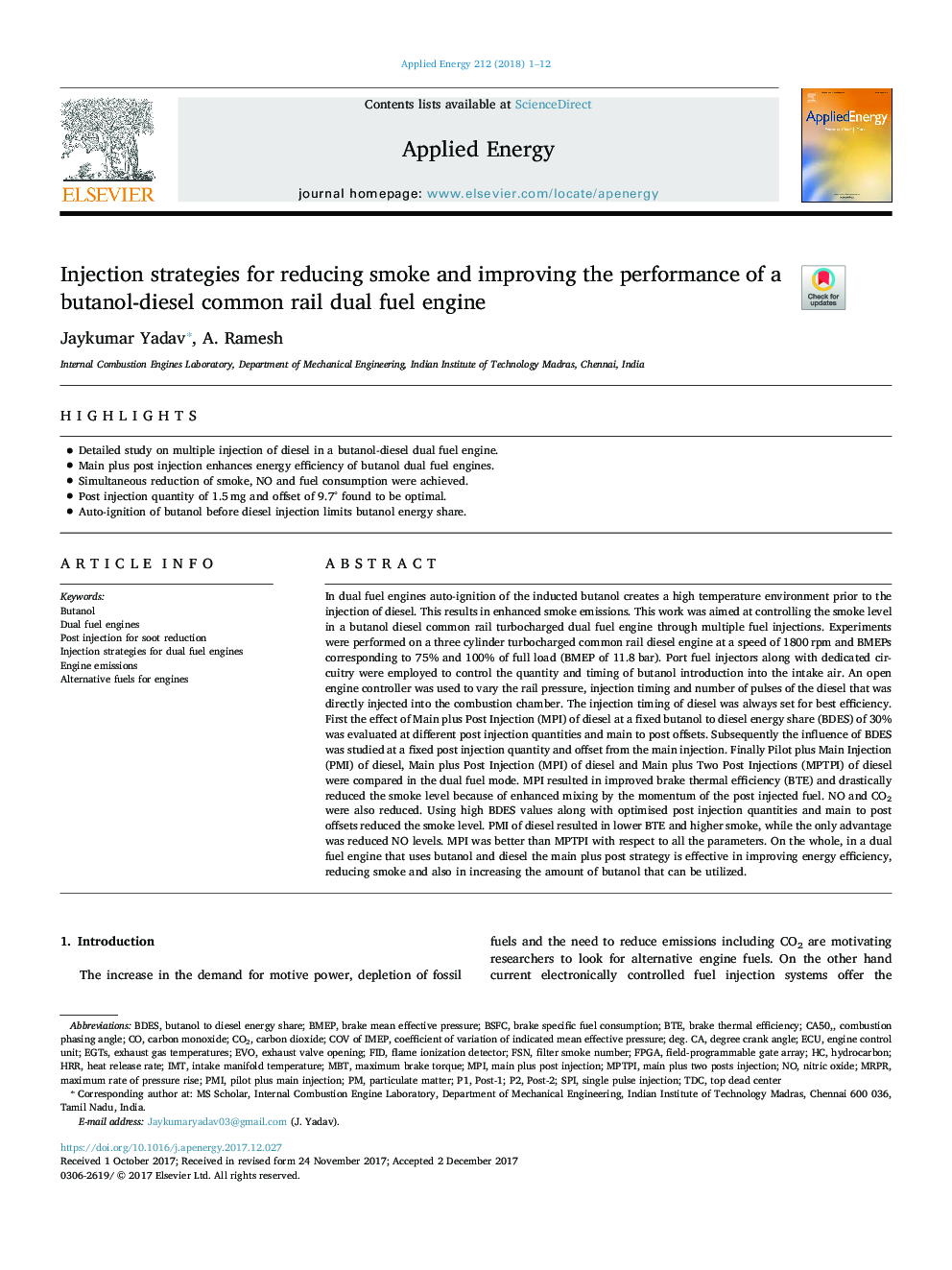| کد مقاله | کد نشریه | سال انتشار | مقاله انگلیسی | نسخه تمام متن |
|---|---|---|---|---|
| 6680863 | 1428078 | 2018 | 12 صفحه PDF | دانلود رایگان |
عنوان انگلیسی مقاله ISI
Injection strategies for reducing smoke and improving the performance of a butanol-diesel common rail dual fuel engine
ترجمه فارسی عنوان
استراتژی های تزریق برای کاهش دود و بهبود عملکرد یک موتور سوخت دوگانه مشترک بطری دیزلی
دانلود مقاله + سفارش ترجمه
دانلود مقاله ISI انگلیسی
رایگان برای ایرانیان
کلمات کلیدی
TDCHRRECUBMEPSPIMBTBSFCMPIBDEsIMTFSNField-programmable gate array - آرایه دروازه قابل برنامه ریزی فیلدflame ionization detector - آشکارساز یونیزاسیون شعلهEngine emissions - انتشار موتورEvo - اویButanol - بوتانولbrake mean effective pressure - ترمز فشار متوسط موثرbrake specific fuel consumption - ترمز مصرف سوخت خاصMaximum rate of pressure rise - حداکثر سرعت افزایش فشارMaximum Brake Torque - حداکثر گشتاور ترمزFID - درExhaust valve opening - دریچه خروجی دریچه بازDual fuel engines - دو موتور سوختCarbon dioxide - دیاکسید کربنparticulate matter - ذرات معلقBrake thermal efficiency - راندمان حرارتی ترمزPMI - شرکتهای کوچک و متوسطFilter Smoke Number - شماره دود فیلترFPGA - مدار مجتمع دیجیتال برنامهپذیرtop dead center - مرکز مرده بالاcarbon monoxide - منوکسیدکربنHeat release rate - نرخ انتقال حرارتNitric oxide - نیتریک اکسیدhydrocarbon - هیدروکربنEngine control unit - واحد کنترل موتورBTE - وسایل کمکCO2 - کربن دیاکسید
موضوعات مرتبط
مهندسی و علوم پایه
مهندسی انرژی
مهندسی انرژی و فناوری های برق
چکیده انگلیسی
In dual fuel engines auto-ignition of the inducted butanol creates a high temperature environment prior to the injection of diesel. This results in enhanced smoke emissions. This work was aimed at controlling the smoke level in a butanol diesel common rail turbocharged dual fuel engine through multiple fuel injections. Experiments were performed on a three cylinder turbocharged common rail diesel engine at a speed of 1800â¯rpm and BMEPs corresponding to 75% and 100% of full load (BMEP of 11.8â¯bar). Port fuel injectors along with dedicated circuitry were employed to control the quantity and timing of butanol introduction into the intake air. An open engine controller was used to vary the rail pressure, injection timing and number of pulses of the diesel that was directly injected into the combustion chamber. The injection timing of diesel was always set for best efficiency. First the effect of Main plus Post Injection (MPI) of diesel at a fixed butanol to diesel energy share (BDES) of 30% was evaluated at different post injection quantities and main to post offsets. Subsequently the influence of BDES was studied at a fixed post injection quantity and offset from the main injection. Finally Pilot plus Main Injection (PMI) of diesel, Main plus Post Injection (MPI) of diesel and Main plus Two Post Injections (MPTPI) of diesel were compared in the dual fuel mode. MPI resulted in improved brake thermal efficiency (BTE) and drastically reduced the smoke level because of enhanced mixing by the momentum of the post injected fuel. NO and CO2 were also reduced. Using high BDES values along with optimised post injection quantities and main to post offsets reduced the smoke level. PMI of diesel resulted in lower BTE and higher smoke, while the only advantage was reduced NO levels. MPI was better than MPTPI with respect to all the parameters. On the whole, in a dual fuel engine that uses butanol and diesel the main plus post strategy is effective in improving energy efficiency, reducing smoke and also in increasing the amount of butanol that can be utilized.
ناشر
Database: Elsevier - ScienceDirect (ساینس دایرکت)
Journal: Applied Energy - Volume 212, 15 February 2018, Pages 1-12
Journal: Applied Energy - Volume 212, 15 February 2018, Pages 1-12
نویسندگان
Jaykumar Yadav, A. Ramesh,
